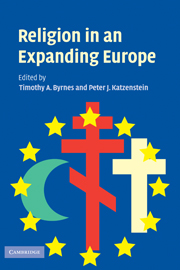Book contents
- Frontmatter
- Contents
- List of contributors
- Preface
- 1 Multiple modernities as limits to secular Europeanization?
- Part I European settings
- Part II Catholicism
- Part III Orthodoxy
- 6 The way we were – and should be again? European Orthodox Churches and the “idyllic past”
- 7 The politics of ambivalence: Europeanization and the Serbian Orthodox Church
- Part IV Islam
- Part V Conclusion
- References
- Index
7 - The politics of ambivalence: Europeanization and the Serbian Orthodox Church
Published online by Cambridge University Press: 22 September 2009
- Frontmatter
- Contents
- List of contributors
- Preface
- 1 Multiple modernities as limits to secular Europeanization?
- Part I European settings
- Part II Catholicism
- Part III Orthodoxy
- 6 The way we were – and should be again? European Orthodox Churches and the “idyllic past”
- 7 The politics of ambivalence: Europeanization and the Serbian Orthodox Church
- Part IV Islam
- Part V Conclusion
- References
- Index
Summary
Religion and Serbia's ambivalent attitude toward the West
The post-1989 Europe's East saw the recovery and growing influence of national Orthodox Churches. In the countries of Eastern Christian tradition religion is a public affair. Eastern Churches are some kind of branches of government often under special laws. Also by tradition, Caesar is always first and the Patriarch (head of the Church) is the ruler's benevolent mentor. The Eastern Orthodox Church remains reserved toward political activism generally much more than Western churches, except in extraordinary circumstances, most notably when a secular authority does not exist or cannot function. The Church then becomes a provisional government of sorts until restoration of secular authority. This practice was in fact strengthened during five centuries of Ottoman rule by the so-called millet system. The Ottomans destroyed Serb nobility and statehood but tolerated and recognized the Church as both spiritual and political representative of the community. This was because Muslim Ottomans knew only one type of community, namely religious community (in this case Christian or “Roman” i.e. Rum millet). This historical experience reinforced the Church's roles as a guardian of national identity and a form of de facto statehood. Thus Orthodox churches entered the modern age of nations as “ready-made nation-states” albeit different from the Western model. By the same token, the Western liberal principle of separation between Church and state in Eastern Orthodoxy has two powerful traditions against it, namely the Byzantine tradition (“caesaropapism”) and the experience of Ottoman rule.
- Type
- Chapter
- Information
- Religion in an Expanding Europe , pp. 176 - 203Publisher: Cambridge University PressPrint publication year: 2006
- 7
- Cited by

